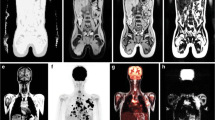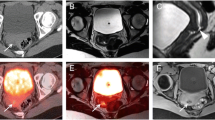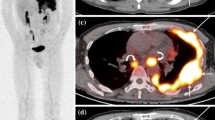Abstract
Pyothorax-associated lymphoma (PAL) is a non-Hodgkin’s lymphoma developing in the pleural cavity after a long-standing history of chronic pyothorax (CP). F-18 fluorodeoxyglucose positron emission tomography (FDG-PET) imaging is a useful modality for determination of disease extent of various malignant tumors, including malignant lymphoma, but there have been no reports describing the usefulness of FDG-PET imaging in PAL. Here we report a case of PAL that relapsed after chemotherapy and was successfully treated by radiotherapy. FDG-PET imaging revealed that the tumor was localized to a soft-tissue attenuation mass behind the CP cavity in the right thorax, but did not infiltrate the CP cavity. A total dose of 40 Gy was administered to the area that included the PET-positive lesion, instead of including the entire CP cavity in the radiation field. Although computed tomography (CT) showed a residual mass, no FDG uptake was indicated by FDG-PET imaging performed just after the end of radiotherapy, and additional irradiation was not performed. No sign of relapse was found by FDG-PET imaging 3 months later. FDG-PET imaging was useful for both the planning of radiotherapy and assessing the treatment response of PAL.
Similar content being viewed by others
Reference
Nakatsuka S, Yao M, Hoshida Y, Yamamoto S, Iuchi K, Aozasa K. Pyothorax-associated lymphoma: A review of 106 cases.J Clin Oncol 2002; 20: 4255–4260.
Kostakoglu L, Goldsmith SJ. Fluorine-18 fluorodeoxyglucose positron emission tomography in the staging and follow-up of lymphoma: is it time to shift gears?Eur J Nucl Med 2000; 27: 1564–1578.
Aruga T, Itami J, Nakajima K, Shibata K, Nojo T, Aruga M, et al. Treatment for pyothorax-associated lymphoma.Radiother Oncol 2000; 56: 59–63.
Yorke ED, Jackson A, Rosenzweig KE, Merrick SA, Gabrys D, Venkatraman ES, et al. Dose-volume factors contributing to the incidence of radiation pneumonitis in non-small-cell lung cancer patients treated with three-dimensional conformal radiation therapy,lnt J Radiat Oncol Biol Phys 2002; 54: 329–339.
Graham MV, Purdy JA, Emami B, Harms W, Bosch W, Lockett MA, et al. Clinical dose-volume histogram analysis for pneumonitis after 3D treatment for non-small cell lung cancer (NSCLC).lnt J Radiat Oncol Biol Phys 1999; 45: 323–329.
Shiroyama H, Koizumi M, Yamashita T. Usefulness of gallium-67 scintigraphy in diagnosing pyothorax-associated lymphoma.KAKU IGAKU (Jpn J Nucl Med) 2001; 38: 223–228.
Spaepen K, Stroobants S, Dupont P, Van Steenweghen S, Thomas J, Vandenberghe P, et al. Prognostic value of positron emission tomography (PET) with fluorine-18 fluorodeoxyglucose ([18F]FDG) after first-line chemotherapy in non-Hodgkin’s lymphoma: is [18F]FDG-PET a valid alternative to conventional diagnostic methods?J Clin Oncol 2001; 19:414–419.
Zinzani PL, Fanti S, Battista G, Tani M, Castellucci P, Stefoni V, et al. Predictive role of positron emission tomography (PET) in the outcome of lymphoma patients.Br J Cancer 2004; 91: 850–854.
Author information
Authors and Affiliations
Corresponding author
Rights and permissions
About this article
Cite this article
Asakura, H., Togami, T., Mitani, M. et al. Usefulness of FDG-PET imaging for the radiotherapy treatment planning of pyothorax-associated lymphoma. Ann Nucl Med 19, 725–728 (2005). https://doi.org/10.1007/BF02985123
Received:
Accepted:
Issue Date:
DOI: https://doi.org/10.1007/BF02985123




